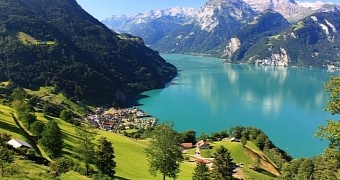This might come as a bit of a shock to some people, but as it turns out, our planet's oceans aren't the only bodies of water that can birth tsunamis. Thus, researchers say that tsunamis can happen in lakes that sit far away from one coast or another as well.
In fact, it was back in 1971 that Peru's Lake Yanawayin produced a pretty impressive tsunami. This massive wave formed in the aftermath of an earthquake that hit the region. When finally reaching land, it killed hundreds of people.
According to Nature, the risk that a tsunami could form in Europe's Alpine region is so high that, not too long ago, high officials in Nidwalden, a canton in central Switzerland, saw fit to include this threat in hazard plans for the region.
The body of water that authorities fear could one day throw a fit and birth one such massive wave is Lake Lucerne. This Alpine lake bounds Switzerland's Nidwalden canton to the north, and sits on fairly shaky ground, specialists explain.
Specifically, it is estimated that, once every millennium – give or take a few decades – the region is hit by earthquakes whose magnitude can go as up as 6 on the Richter scale. It is one such event that authorities in Nidwalden believe that can cause a tsunami to form.
Then again, Lake Nidwalden might also produce a tsunami, were it to be hit by a rockslide powerful enough to shake it to the core. Like the massive waves that could form in the aftermath of major earthquakes, one such tsunami would constitute a threat to local communities.
Information shared with the public says that, looking to be prepared for either one of these scenarios, high officials in Nidwalden have asked specialist Flavio Anselmetti with the University of Bern and several other researchers to map the area and pin down the regions most at risk.
The data provided by these scientists will serve to better existing evacuation plans. The information will also be taken into account when various construction plans are submitted for approval. The end goal is to make sure that, should a tsunami hit the region sometime in the not-so-distant future, it won't get to cause all that much damage.
Scientists say that, according to evidence at hand, Lake Lucerne last put on a show back in the 17th century. At that time, it birthed two tsunamis, one of which stood approximately 5 meters (roughly 16.4 feet) tall. The lake's underwater slopes currently pack a considerable amount of sediment that could produce yet another massive wave if dislodged by an earthquake.

 14 DAY TRIAL //
14 DAY TRIAL //